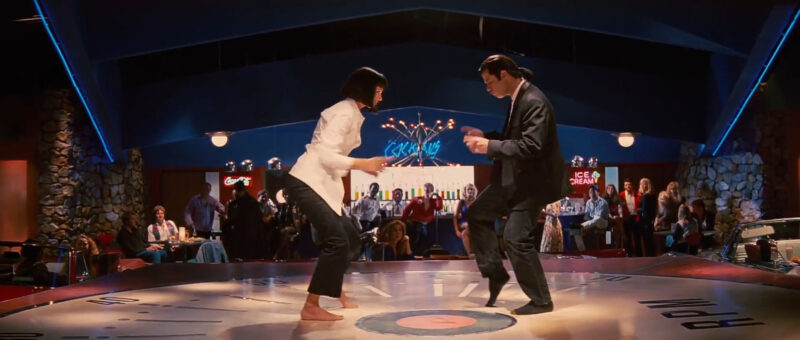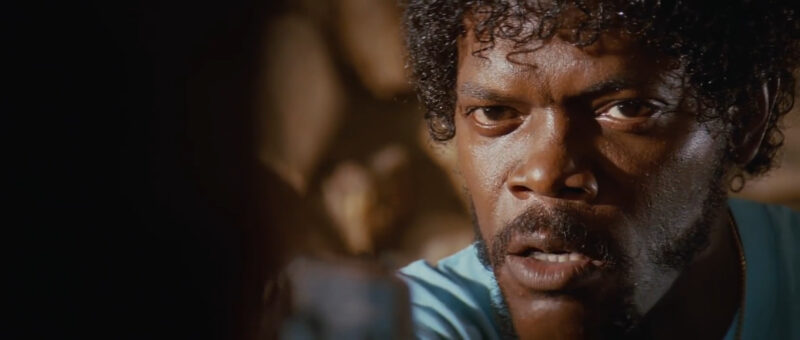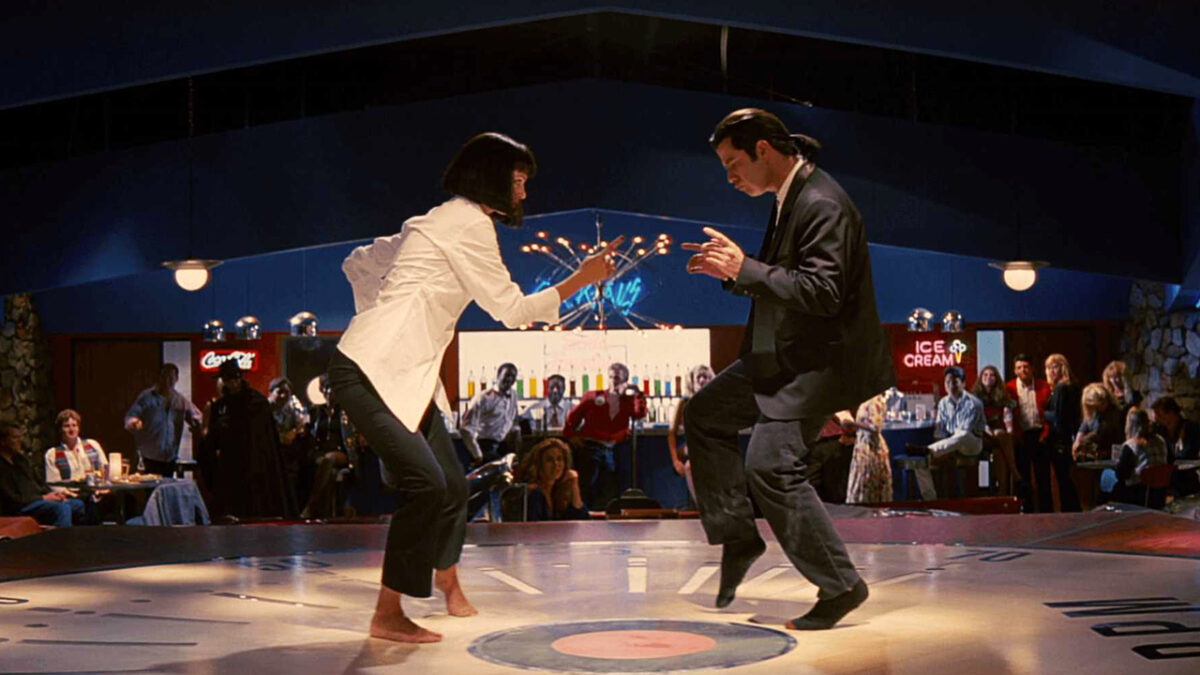In this section of our Colossus Movie Guide for Pulp Fiction, we look at the key shots that help us understand the film.
Cast
- John Travolta – Vincent Vega
- Samuel L. Jackson – Jules Winnfield
- Uma Thurman – Mia Wallace
- Bruce Willis – Butch Coolidge
- Ving Rhames – Marsellus Wallace
- Harvey Keitel – Winston Wolfe
- Tim Roth – Ringo
- Amanda Plummer – Yolanda
- Eric Stoltz – Lance
- Rosanna Arquette – Jody
- Christopher Walken – Captain Koons
- Quentin Tarantino – Writer and director
Key shots of Pulp Fiction
The Dance at Jack Rabbit Slim’s

In the memorable scene where Mia and Vincent take part in the twist contest at Jack Rabbit Slim’s, the shot where they dance together is of significant importance. It’s a medium shot, capturing both Mia and Vincent in their entirety as they move around the dance floor. The camera’s distance allows us to fully appreciate their body language, from their footwork to their facial expressions, and the simplicity of the staging places the focus solely on them.
The significance of this shot lies in how it visually encapsulates the rapport and temporary intimacy between the two characters. It interrupts the tension that builds up during their dinner conversation, providing a moment of shared enjoyment and camaraderie. The iconic dance move with their pointed fingers is a defining image that symbolizes their temporary departure from their complicated lives.
This scene also underscores Pulp Fiction‘s unique blend of pop culture and profound themes. The dance scene is light and fun, yet it occurs amidst a narrative woven with violence and moral conflict. Thus, the shot serves as a microcosm of the film’s overall approach, intertwining moments of levity with its deeper explorations of character and morality.
The Gold Watch Flashback

The shot of Captain Koons delivering the gold watch to a young Butch is an important symbol of the film’s exploration of legacy and honor. In this shot, Koons is captured in a close-up, a visual choice that emphasizes the gravity of his words and the significance of the watch. The camera’s positioning, the lighting, and the framing all contribute to highlighting the weight of the past, the respect for sacrifice, and the responsibility of legacy that the watch carries.
As we follow the narrative, we see how the watch becomes the catalyst for Butch’s transformation. Despite the watch being a symbol of the past, it ironically leads to Butch’s liberation from his cycle of violence. His willingness to risk his life for the watch leads him into direct conflict with Marcellus, but this conflict concludes with a pact of peace. Therefore, the shot of the watch not only introduces its importance but foreshadows the theme of unexpected consequences.
The Completion of Jules’ Transformation

In the concluding diner scene, the shot of Jules reciting Ezekiel 25:17 and disarming Ringo is of significant importance. The camera focuses on Jules in a close-up shot, emphasizing his transformation from a hitman to a peace-seeking man. His composed demeanor contrasts sharply with the high-stress situation, underscoring the depth of his transformation.
This shot visualizes the thematic resolution of personal redemption. Throughout the film, we’ve seen characters navigate the chaos of their violent lives, often with disastrous consequences. Yet, in this moment, Jules defuses a potentially lethal situation not with violence, but with words. The choice to focus on Jules in this scene visually highlights his character’s evolution, offering a hopeful resolution to the film’s exploration of choice and redemption.
Despite his violent past, Jules manages to choose a different path, demonstrating that redemption is possible even in the most dire of circumstances. His calmness and wisdom stand in stark contrast to the volatile setting of the diner hold-up, and the shot itself embodies the film’s exploration of the transformative power of choice.
What are your thoughts?
Are there more shots you think should be part of the Colossus Movie Guide for Pulp Fiction? Leave your thoughts below and we’ll consider adding them.

